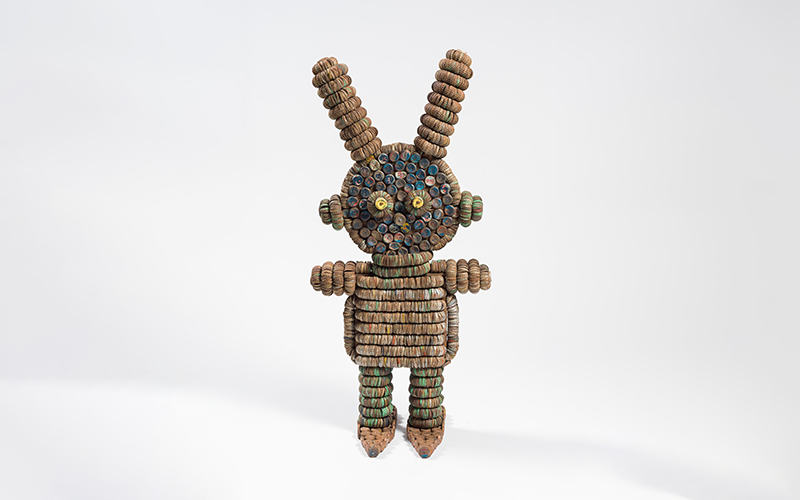
Clarence Woolsey (American, 1909–1987) and Grace Woolsey (American, 1921–1992), Caparena Figure, 1961–71, bottle caps, wire, wood, and nails, 40 x 18 1/2 x 13 in. (101.6 x 47 x 33 cm), Collection of Richard Rosenthal
Verbal Description
Hello, my name is Jeff Burkart, and I am a gallery attendant at the museum. I will be reading the verbal description for Caparena Figure by Clarence Woolsey and Grace Woolsey in Creating Connections: Self-Taught Artists in the Rosenthal Collection.
Clarence Woolsey was an American artist who lived from 1909 to 1987. His wife and fellow artist, Grace Woolsey, was also an American and lived from 1921 to 1992. Between 1961 and 1971, they created the sculpture, Caparena Figure, using bottle caps, wire, wood, and nails. It is in the collection of Richard Rosenthal.
Clarence and Grace Woolsey’s Caparena Figure measures 40 inches tall by 18 and one-half by 13 inches or 101.6 by 47 by 33 centimeters. This (quote) “Bear,” as Clarence Woolsey called it, is a freestanding sculpture made from old, weathered bottle caps, wire, wood, and nails. The figure has a round, flat face made mostly from blue bottle caps. The artists crafted the eyes using coils of nestled bottle caps in assorted colors surrounding yellow caps for the irises. The same coiled bottle cap style is used for two circular forms resembling hair buns, one on each side of the head. Protruding from the top of the head are two rabbit-like ears, each made from nine rings of bottle caps. The body and legs of the sculpture are crafted using horizontal rows of stacked caps. Two short arms stick out straight on the sides of the body. The feet, also made from bottle caps, resemble snowshoes.
Label Text
Hello, my name is Jeff Burkart, and I am a gallery attendant at the museum. I will be reading the label for Caparena Figure by Clarence Woolsey and Grace Woolsey in Creating Connections: Self-Taught Artists in the Rosenthal Collection.
Clarence Woolsey was an American artist who lived from 1909 to 1987. His wife and fellow artist, Grace Woolsey, was also an American and lived from 1921 to 1992. Between 1961 and 1971, they created the sculpture, Caparena Figure, using bottle caps, wire, wood, and nails. It is in the collection of Richard Rosenthal.
Is this tall-eared creature a rabbit or an alien with antennae? Hundreds of colorful metallic bottle caps with crimped edges give this ingenious sculpture a rough texture and subtle shimmer. The caps are oriented tops-out for the face, eyes, and feet, and wired together in coils to compose much of the sprightly piece. According to the Woolseys’ nephew, Grace was the creative mind behind this farm couple’s work, which began as a pastime on a snowy night in 1961. Clarence made wood frames from old fruit crates to form the underlying structures.
By 1971, there were more than 100 of these figures, at once delightful, strange, and abstract. For 25 cents, you could see them displayed in Lincoln, Iowa, with an array of the Woolseys’ other bottle-cap creations, including small buildings, mailboxes, and a full-size bicycle. They called their exhibition “The World’s Largest Pioneer Caparena” (or “Cap-Arena”).
